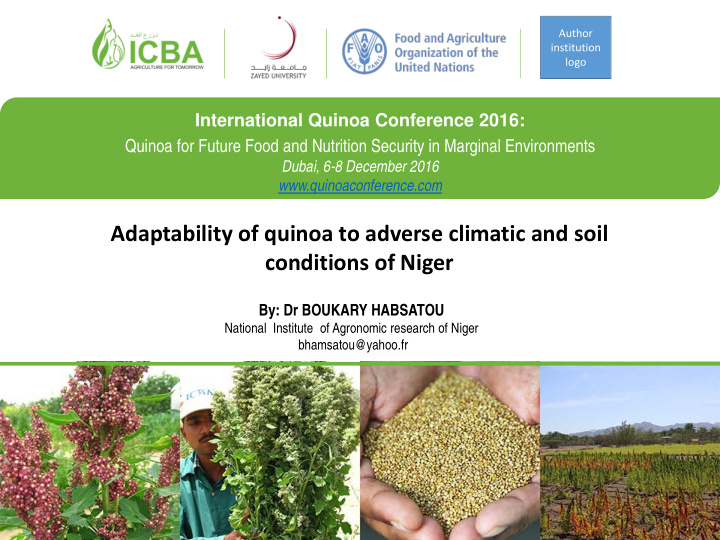



Author institution logo International Quinoa Conference 2016: Quinoa for Future Food and Nutrition Security in Marginal Environments Dubai, 6-8 December 2016 www.quinoaconference.com Adaptability of quinoa to adverse climatic and soil conditions of Niger By: Dr BOUKARY HABSATOU National Institute of Agronomic research of Niger bhamsatou@yahoo.fr
Background/Introduction Key challenges are: • The vulnerability of populations of Niger to recurring shocks limit not only agricultural and livestock production but also economic growth • Limited access to protein sources and limited production conditions due to insufficient rainfall, reduced availability of inputs and aridity such as Niger • No-agricultural development and sustainable food insecurity that requires the introduction of high-value crops such as quinoa. • The lack of knowledge about the nutritional benefits of quinoa and its contribution to the fight against food insecurity
Materials and Methods Experimental site location Sites : Konni, Tillabéry and Maradi
Materials and Methods . Climate and soil types Sites Agro- Temperature Rainfall Soil types écologica Max Min. Max. Min. l zones Konni Sahelian 42 ° C 12 ° C 600 350 Tropical or slightly leached mm mm tropical ferruginous soils, associated with poorly developed gravelly soils Tillabery Sahelo- 44 ° C 15 ° C 350 150 Poorly developed soils, isohumic saharian mm mm soils, and hydromorphic soils with real possibilities for irrigated crops Maradi Sahélo- 40 ° C 10 ° C 800 600 Hydromorphic soils associated soudanian mm mm with ferruginous soils
Materials and Methods Applied treatments • Treatments: 2 Quinoa varieties (Puno and Titicaca) • The trial was conducted in a RCBD with four (4) replications. • Seeding was done in plots of 10 m 2 (2 m x 5 m). • The distance between to line was 0.5 m and 0.25 m between plants on same the lines
Results Growth Parameters Qualitatives characters of quinoa in Maradi Varieties Panicle Panicle Panicle size Panicle Dehiscence Color at Color at density degree bloom maturity Puno Green Pink Intermediate Compact Strong Titicaca Purple Orange Amarantifor Average Normal me Plants of Puno (left) and Titicaca (right) in Maradi
Quantitative Growth Parameters parameters Panicle length Plant height Yield 4.5 4 Panicle Width 3.5 Limbe length 3 2.5 2 1.5 1 0.5 0 1000 GR weigth Limbe width Puno Titicaca
Conclusions and recommandations • The quinoa can be growing in Niger • Limited quantity of genetic material • The data is collected only in Maradi, no it is to short to conclude the result of Konni and Tillabéry; • the experimentation will be done this season with more materials • The quinoa program is young in Niger, so better knowledge of the advantage of this crop by the population is necessary ;
THANK YOU FOR YOUR ATTENTION
Recommend
More recommend